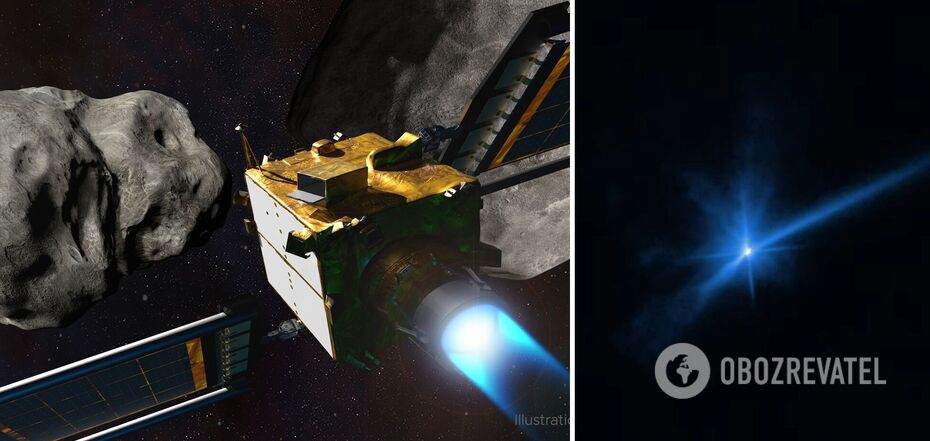Life
NASA successfully rammed an asteroid, but it didn't go according to plan: scientists are surprised. Video
In September 2022, NASA conducted its first-ever successful collision of the DART spacecraft with the asteroid Dimorphos to see if it could be knocked off its existing trajectory. At that time, the space agency declared the mission a success. However, scientists who continued to monitor how the Earth's "victim" would behave were surprised by what they saw.
The scientific journal Nature published five articles at once about what scientists saw and how it can help mankind in the future. ScienceAlert recounts the main one.
Why was it necessary to ram the asteroid?
NASA is not known for hating asteroids, wanting to break something, or just throwing money away. The idea that the spacecraft would ram an asteroid circling the Earth had a perfectly scientific basis.
Thus scientists tried to find out whether humanity would be able to change the trajectory of the asteroid if it suddenly flew in the direction of Earth and threatened humanity with problems.
Not that this was an urgent question, since in the next 100 years none of the known asteroids will threaten mankind, but it is better to be sure in advance. Especially since the scientists believe that it is necessary to knock the asteroid out of its orbit 10 years before the collision.
What scientists found
Immediately after the test collision of DART with the asteroid, NASA declared the mission successful and confirmed that the asteroid changed its orbit as a result of the impact. But, as it turned out, the interesting stuff started next.
The asteroid Dimorphos, 160 meters in diameter, revolves around its larger counterpart, the 780-meter Didymos, about once every 11.9 hours; after the collision, scientists calculated, its orbital period should have changed by about 7 minutes. And the collision did result in an altered rotation period, but...
A paper led by planetary astronomer Christina Thomas of Northern Arizona University (USA) said that the following studies showed that there was a much larger change and that Dimorphos now revolves around Didymos 33 minutes faster than before the collision. The results were checked twice, using different methods, but the data turned out to be correct.
Scientists realized that such a large change in the orbital period could not have happened due to the momentum transfer from the DART spacecraft. So the research continued.
A paper led by astronomer Jian-Yang Li of the Institute of Planetary Sciences (USA) analyzed in detail the data on the material ejected from the asteroid as a result of the impact. It turned out that after the collision, Dimorphos continued to emit dust tails for almost two more weeks.
Researchers from the SETI Institute in the United States have also confirmed a significant dust emission. They observed the brightness of Dimorphos before, during, and after the impact. It turned out that the asteroid did not return to its original brightness until three weeks after the collision. According to the researchers' calculations, Dimorphos lost between 0.3 and 0.5 percent of its total mass during this period.
Astronomer Andrew Chen of the Applied Physics Laboratory at Johns Hopkins University, USA, and his team also tracked the asteroid after the collision and were able to determine that it was the dust ejection that gave Dimorphos more momentum than the DART spacecraft at the time of the collision.
Here's how the Hubble telescope saw the collision
Finally, a team led by planetary scientist Terick Daly of the Johns Hopkins University Applied Physics Laboratory (USA) reconstructed the collision from the data they collected, including a pre-collision timeline, a detailed characterization of the collision site, and the size and shape of Dimorphos.
Their findings were promising. They were able to establish that humanity could successfully deflect the asteroid off its course with limited knowledge of its composition and surface condition without a costly and time-consuming reconnaissance mission.
With this in mind, the information we receive from DART is invaluable. It will help model and plan for future asteroid deflections to better predict the consequences of a spacecraft collision.
"The successful collision of the DART spacecraft with Dimorphos and the resulting change in the orbit of Dimorphos demonstrates that kinetic impactor technology is a viable technique for potentially protecting Earth if necessary," Daly and his team summarized.
Earlier OBOZREVATEL also told about scientists' predictions about what could happen to humanity in the event of an asteroid collision with the Earth.
Subscribe to OBOZREVATEL channels in Telegram and Viber to keep up with the latest developments.




























